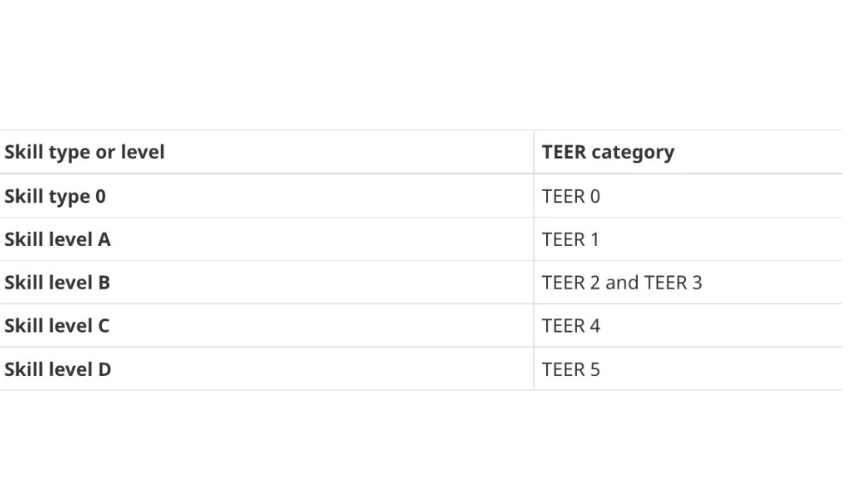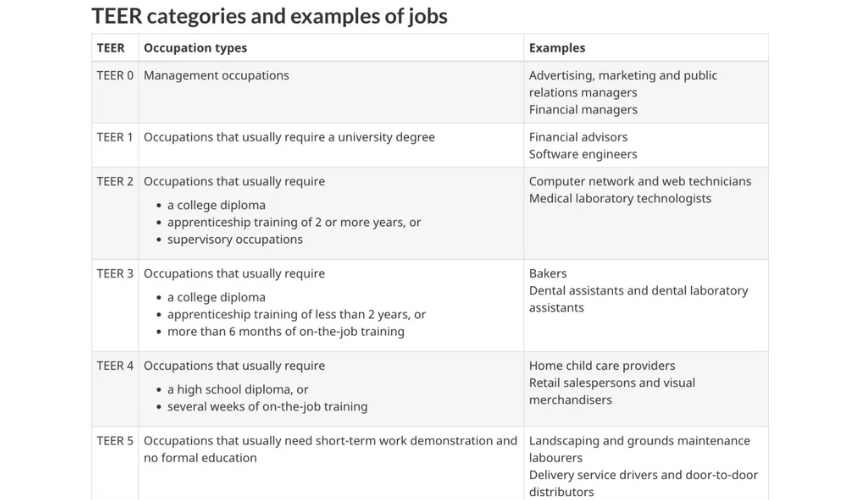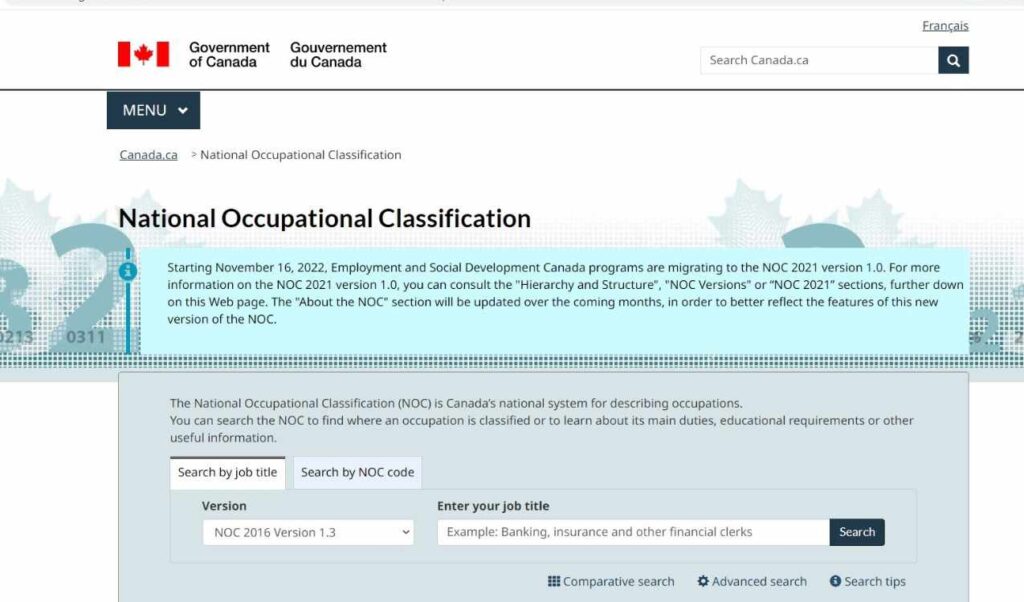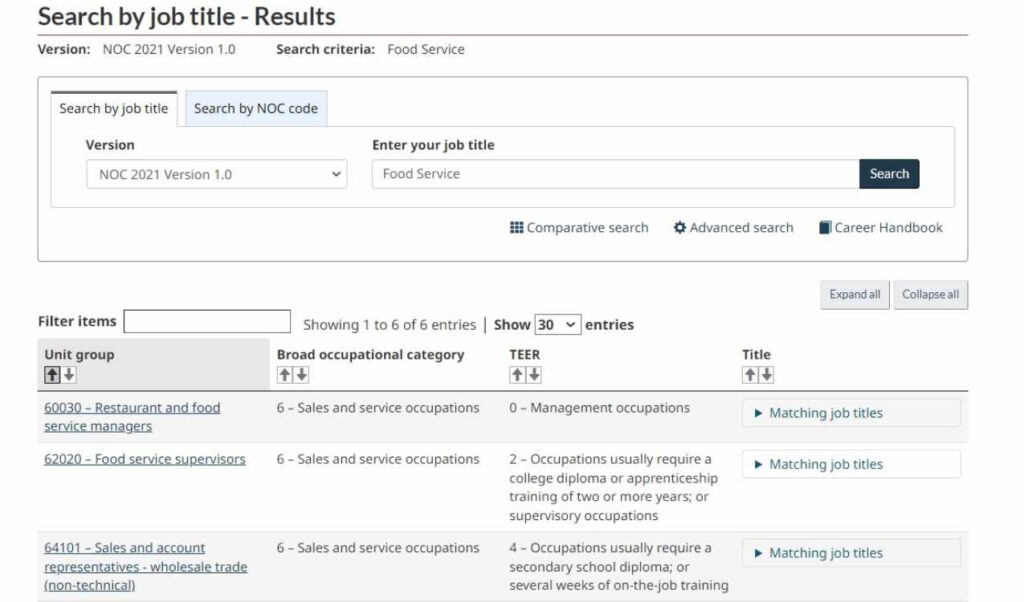TEER NOC Code Canada: A Step-by-Step Guide To Find Your Code
What is the purpose of using the TEER NOC Code in Canadian immigration?
A crucial tool in the Canadian immigration procedure is the National Occupational Classification (NOC) code. It serves several purposes in the context of immigration:
- Determining Eligibility: The NOC code helps determine a candidate’s eligibility for several immigration schemes. Depending on the profession, different programmes have unique prerequisites. IRCC officers can determine if an application satisfies the programme’s requirements by comparing the applicant’s occupation to the appropriate NOC code.
- Express Entry System: The Federal Skilled Worker Programme, the Federal Skilled Trades Programme, and the Canadian Experience Class are three economic immigration programmes managed via the Express Entry system, which heavily relies on the NOC code. The number of points given to candidates depends on their NOC code, level of education, language ability, employment history, and other variables. These factors impact how they rank in the Express Entry pool and how likely they are to receive an invitation to apply for permanent residence.
- Labor Market Impact Assessment (LMIA): The LMIA procedure, which evaluates the effect of employing a foreign worker on the Canadian labour market, also uses the NOC code. When filing for an LMIA, employers must provide the pertinent NOC number to show that they have tried to hire Canadian citizens or permanent residents before looking for a foreign worker.
- Job Bank Registration: The Federal Skilled Worker Programme, for example, requires candidates to register with the Job Bank. According to candidates’ abilities and credentials, the NOC code connects them with possible Canadian companies.
- Data Collection and Analysis: The NOC code assists in collecting and analyzing labour market data, allowing academics and policymakers to learn more about the Canadian workforce. It aids in pinpointing labour shortages, evaluating the demand for various professions, and formulating plans to satisfy Canada’s economic and labour market demands.
Important:
The 2021 National Occupation Classification (NOC) system transition by Immigration, Refugees and Citizenship Canada (IRCC) changed the requirements for some of Canada’s immigration programs, notably Express Entry.
What is the TEER system Canada 2022?
TEER code Canada is the national standard for occupations in Canada. To collect, analyze, and transfer occupational data for labour market information and employment-related program management, it provides a systematic classification structure that categorizes the entire range of occupational activity in Canada.
Why is the NOC code given, and Who uses the NOC code?
The NOC is a mechanism for describing Canadians’ occupations. It provides a uniform framework for describing and comprehending the nature of work for statisticians, labour market analysts, career counsellors, employers, and individual job searchers. Using the NOC matrix, the NOC assigns a code, known as the NOC TEER codes 2021, to each occupation in the Canadian labour market.
What are the changes to NOC System?
On November 16, 2022, IRCC changed to the NOC TEER codes 2021 (Versus the NOC 2016 version). The NOC organizes occupations by assigning them a Training, Education, Experience, and Responsibilities (TEER) category.
There are six different TEER categories ranging from TEER 0 to TEER 5. This means a 6-category system required to work in an occupation has replaced the NOC 2016 skill type and level structure (NOC 0, A, B, C, and D). The 4-digit Canada NOC codes in 2016 will become 5-digit Canada NOC codes in 2021. The second digit of your NOC code indicates your TEER category.
Understanding New NOC Categories
Canada’s new NOC TEER codes 2021, and TEER categories will be used in place of skill types or levels for all previous programs. Many positions will continue to fall under the TEER category, corresponding to the below-listed skill level. However, some positions might transition to different TEER categories. The most significant change is the Skill Level B jobs subdivision that will now become TEER 2 or TEER 3 jobs. The distribution of skill types or levels and matching TEER categories are shown in the table below.

In the 2021 version of the NOC, the training, education, experience, and responsibilities (TEER) categories are:

How can I find TEER code Canada (find your NOC)?
Here are the steps to find the new NOC 2021 code.
Step 1: Go to the search page of the NOC official website.

Step 2: On this screen, you can do a JOB TITLE or NOC code search.
When a drop-down choice appears, you will choose the most recent version. Look for the “Version” column and click on the “NOC 2021 Version 1.0” if you wish to search by job title.

Step 3: Enter your JOB TITLE after choosing the new NOC 2021 version to discover your NOC 2021 code and TEER category.

Below is an example of a job titled Food Service. You can see more job titles that are similar.

Which Immigration Programs were affected by Canada NOC TEER codes 2021?
All IRCC Canada Immigration programs that have invited applicants using NOC skill types or levels will be impacted. Express Entry Canada and several other Canadian immigration streams, including Temporary Foreign Work Permit (TFWP), are affected by Canada’s new NOC TEER codes 2021 and TEER categories. As a result, all the programs listed below will start using TEER levels and Canada’s new NOC TEER codes in 2022.
- Express Entry – Federal Skilled Worker Program (FSWP)
- Express Entry – Canadian Experience Class (CEC)
- Express Entry – Federal Skilled Trades Program (FSTP)
- Atlantic Immigration Program (AIP)
- Provincial Nominee Program (PNP)
- Caregivers Programs
- Rural and Northern Immigration Pilot
- Agri-Food Pilot
- Work Permit – International Mobility Program (IMP)
- Work Permit – Temporary Foreign Worker Program (TFWP)
Implementing the new TEER system, Canada will make several professions eligible for and ineligible for participation in a few programs.
Which new TEER system Canada are ineligible for Express Entry?
The following three professions are no longer eligible for the Express Entry programs, per NOC TEER codes 2021.
- Program leaders and instructors in recreation, sport, and fitness
- Tailors, dressmakers, furriers, and milliners
- Other performers
Other Canada PR immigration pathways with greater occupational eligibility requirements, like several streams of the PNPs across Canada, continue to accept applicants in the three newly disqualified occupations.
Which TEER is eligible for express entry?
Implementing the new TEER system will make several professions eligible for Express Entry. The following 16 occupations are now eligible through the Express Entry system.
- Nurse aides, orderlies, and patient service associates
- Pharmacy technical assistants and pharmacy assistants
- Dental assistants and dental laboratory assistants
- Elementary and secondary school teacher assistants
- Bus drivers, subway operators, and other transit operators
- Aircraft assemblers and aircraft assembly inspectors
- Estheticians, electrologists, and related occupations
- Residential and commercial installers and servicers
- By-law enforcement and other regulatory officers
- Pest controllers and fumigators
- Correctional service officers
- Sheriffs and bailiffs
- Payroll administrators
- Heavy equipment operators
- Transport truck drivers
- Other repairers and servicers
What NOC is good for Canada PR?
There are many immigration streams that you could be eligible for Canada PR, depending on the category of your NOC code:
- You are eligible for the three federal Express Entry programs and some streams of the Provincial Nominee Programs if your NOC code is TEER 0, 1, or 3.
- If your NOC code is TEER 4 or 5, you may qualify for Provincial Nominee Program streams, including the Yukon, Northwest Territories, and Prince Edward Island PNPs.
- If your NOC code is TEER 0, 1, 2, 3, or 4, you may be qualified for the Atlantic Immigration Program.
How do I decode NOC TEER codes 2021?
Learning how to decode the Canada NOC TEER codes 2021 is so important. Here is the decoding formula and an example of that:
Nomenclature and number of categories within each level of NOC 2021 Version 1.
Example of coding in NOC 2021: Judges, lawyers, and Quebec notaries NOC CODE 41100
Level (Title of Hierarchy) | Coding | Represents | NOC TEER Codes 2021 | NOC 2021 Title |
Broad Category | First Digit | Occupational categorization | 4 | Occupations in education, law and social, community, and government services |
Major Group | Second Digit x | TEER categorization | 41 | Professional occupations in law, education, social, community, and government services |
Sub-Major Group | 3-digit | Top-level of the Sub-Major Group | 411 | Professional occupations in law |
Minor Group | 4-digit | Hierarchy within the Sub-Major Group | 4110 | Judges, lawyers, and Quebec notaries |
Unit Group | 5-digit | Hierarchy within the Minor Group | 41100 | Judges |
TEER NOC CODES FAQs
Suppose you submitted your Express Entry profile before November 16, 2022, but have not yet received an invitation to apply (ITA). In that case, you must update it with your updated NOC TEER Codes 2021 and TEER category.
If you get an ITA before November 16, 2022, you can use the NOC 2016 system to submit your Express Entry application. Additionally, you can submit your application under the NOC TEER code listed on your ITA receipt. If, however, you received an ITA before November 16, there is no requirement for you to update to new NOC codes.
The points distribution would be the same as with NOC 2016. For instance, Express Entry candidates with arranged employment in Skill Type/Level 00 (NOC 2016) have received 200 additional CRS (Comprehensive Ranking System) points. In the same way, candidates will continue to get 200 extra points with Canada’s new NOC TEER codes 2021. Your job experience must have been in TEER 0 (NOC 2021 codes).
One of the most crucial parts of your immigration application is selecting the appropriate NOC code. Your application can be turned down or sent back to you if you claim a NOC code that doesn’t correspond to your employment history. It is your responsibility to make sure that you select proper Canada’s new NOC TEER codes 2021 and that you have the supporting documentation. A job title accompanies each NOC TERR code, lead statement, and summary of primary responsibilities.
Your job title is irrelevant to obtaining your new NOC codes for Canadian immigration. Instead, you should have a substantial number of activities and responsibilities, and your work experience must align with the lead statement. Therefore, your professional experience may fall under a few different categories.
TEER 2 covers jobs that usually require a college diploma, apprenticeship training of 2 or more years, as well as occupations with supervisory occupations.
TEER Category | NOC Code | Class title |
2 | 12101 | Human resources and recruitment officers |
2 | 12102 | Procurement and purchasing agents and officers |
2 | 12103 | Conference and event planners |
2 | 12104 | Employment insurance and revenue officers |
2 | 12111 | Health information management occupations |
2 | 12112 | Records management technicians |
2 | 12200 | Accounting technicians and bookkeepers |
2 | 12201 | Insurance adjusters and claims examiners |
You can be ready by being aware of the recent modifications to the TEER lead statements and significant responsibilities. The responsibilities listed in your new Canada NOC codes and TEER category must be reflected in your work experience letter, although many of them may be comparable. Plus, if you wish to receive points for your professional experience inside and outside Canada, you must also continue to perform the duties associated with your NOC TEER Codes employment.
Some immigration programs only accept applicants who meet certain skill levels (formerly known as Noc code levels). Before this, NOC Skill Level B or above was necessary for eligibility in the Express Entry programs. The Express Entry qualifying threshold will change to TEER 3 with NOC 2021.
Any activity with a TEER code of 0, 1, 2, or 3 is classified as high-skilled labour for immigration purposes. Any job with a TEER level of 4 or 5 is considered low-skilled labour.
Professional jobs that normally need a university degree are referred to as having a skill level of A. Engineers, physicians, and financial auditors are some examples.
A college degree or training as an apprentice is typically required for skilled trades or technical employment at skill level B.
Yes, you can obtain PR if you have expertise working in a position that falls under NOC codes C or D. If you are employed in an NOC codes C or D occupation, you have a variety of immigration alternatives to Canada.
Since 1992, IRCC has used various iterations of the NOC system to categorize and classify occupations for immigration-related purposes.
The NOC system switched from the NOC 2016 to the new version of NOC 2021 codes as of November 16, 2022. Canada’s new NOC TEER codes 2021 system changed from skill type to TEER categories, among other modifications. After November 16, all new applications must be submitted using the appropriate NOC TEER codes 2021. To evaluate the occupations of skilled workers’ permanent residence and work permit applicants, Immigration, Refugees and Citizenship Canada (IRCC) and Employment and Social Development Canada (ESDC) are employing the National Occupation Classification (NOC) system as of November 16, 2021.
The TEER category system’s first goal is to clarify what education and work experience are necessary for each job. Second, the skill type model artificially divides employment into low- and high-skilled categories.
You can obtain Canadian PR with NOC B or NOC C jobs. Several programs assist you in becoming eligible for Canada permanent residence (Canada PR), such as Provincial Nominees Programs (PNPs).
The application will be rejected if your NOC code is wrong, meaning that the job duties listed in the reference letter do not correspond to those listed in the NOC.
Candidates for the Express Entry programs or any other Canadian immigration program must determine which National Occupational Classification (NOC) best describes their experience. Therefore, choosing the right NOC code is essential to successful immigration to Canada.
NOC skill level B is for professions typically requiring a college degree or apprenticeship training.
Canada NOC codes 2021 are used by Immigration, Refugees, and Citizenship Canada (IRCC) to categorize jobs (occupations) and assess each applicant’s work history. When asked to describe their employment experience, immigrants must always choose the NOC code that best describes their experience. Even applicants with experience in professions denoted by NOC TEER codes 2021 are restricted from specific economic immigration streams. Therefore, it’s crucial that you, as a candidate, are aware of how Canada’s new NOC TEER codes 2021 work.
The kind and quantity of training or education typically needed to do employment corresponds to the skill level in the NOC. The second number of the NOC code can be used to identify the four skill levels, A through D, that make up the NOC. Each skill level is given a two-digit number between 0 and 7. For instance, the skill level assigned to a NOC code is A when the second digit is a 0 or a 1. The complete relationship between the alphabetical skill level indicator and its corresponding numerical digits is shown in the table below:
Skill level (alpha) | Skill level (digit) | Nature of education/training |
A – Occupations usually require a university education. | 0 or 1 | University degree at the bachelor’s, master’s, or doctorate level. |
B – Occupations usually require a college education, specialized training, or apprenticeship training. | 2 or 3 |
|
C – Occupations usually require secondary school and occupation-specific training. | 4 or 5 | Some secondary school education, with up to two years of on-the-job training, training courses, or specific work experience |
D – On-the-job training is usually provided for occupations. | 6 or 7 |
|
Firefighters, police officers, and licensed nursing assistants are just a few professions with significant health and safety obligations and are classified as having skill level B.
During the pandemic, the Canadian government has worked to assist immigrants. Industrial butchers, long-haul truck drivers, and servers of food and beverages are a few examples of NOC C jobs. Examples of NOC D occupations include fruit pickers, cleaning staff, and oil field workers.
- 200 CRS points for a valid job offer at NOC 00 jobs.
- 50 CRS points for a valid job offer for any other NOC 0, A and B jobs.
- NOC 0014 (Hospital Administrator)
- NOC 10022 (Advertising, marketing, and public relations managers)
- NOC 10030 (Telecommunication carriers’ managers)
- NOC 11200 (Human resources professionals)
- NOC 11202 (Professional occupations in advertising, marketing, and public relations.
- NOC 1243 (Medical Administrative Assistant)
- NOC 1243 (Medical Secretary)
- NOC 33102 (Nurse Aides)
- NOC 3212 (Medical Laboratory Technician)
- NOC 65200 (Food and beverage servers)
- NOC 65201 (Food counter attendants, kitchen helpers and related support occupations)
- NOC 65310 (Light Duty cleaners)
- NOC 73300 (Transport truck drivers)
- NOC 73400 (Heavy Equipment operators)
- NOC 75110 (Construction trades helpers and labourers)
Starting on November 16, 2022, the NOC 2016 skill type 0 and NOC skill level A will be modified to the NOC 2021 Training, Education, Experience and Requirements (TEER) 0 and TEER, respectively. Therefore, for any employment offer made on or after November 16, 2022, you must use Canada’s new NOC TEER codes 2021.
NOC or Skill Level B positions are in the technical or skilled trades. A college diploma, specialized training, or an apprenticeship are usually required. To apply for a Canada work visa, you must meet the IRCC’s requirements for NOC codes.
Yes, you can get PR if you have work experience in a job classified as NOC C or D. If you work in a NOC C or D occupation, you have many options for immigrating to Canada, including Atlantic Immigration Program (AIP).
NOC Skill Level 0 occupations include restaurant managers, mine managers, senior managers, and so on. NOC Skill Level A occupations include doctors, dentists, architects, and others. These jobs typically necessitate a degree from an accredited university.
Yes, you can. Most Provincial Nominee Programs (PNPs) applicants in National Occupational Classification (NOC) skill levels C and D occupations must take mandatory language tests and achieve a minimum standard of Canadian Language Benchmark (CLB) 4 in each of the four abilities (listening, speaking, reading, and writing).
Using NOC 2016, occupations with Skill Level B or higher are eligible for Express Entry, while in TEER codes categories, TEERs 0, 1, 2, and 3 will be eligible under NOC 2021.
Yes. PR applicants are highly motivated to seek out and accept employment with NOC B or higher positions, as this will allow them to secure enough eligible working hours to include in their permanent residence applications.
Yes, as of November 16, 2022, Canada’s new NOC TEER codes 2021 were replaced by Training, Education, Experience and Responsibilities (TEER) categories.
Immigration, Refugee, Citizenship Canada (IRCC) used the NOC system to determine a candidate’s eligibility for Express Entry. They accepted the candidates with work experience in NOC skill types A, B, or 0 under the eligibility of the Express Entry system. The IRCC updated their NOC 2021 to the new TEER system on November 16, 2022.
Skill Level B is the technical jobs and skilled trades typically requiring a college diploma or apprenticeship training, such as chefs and plumbers.
On the NOC list, semi-skilled and low-skilled occupations are classified as Skill levels C and D. As a result, if your occupation falls into this category, several provincial programs can assist you in obtaining permanent residence.
NOC Skill Level 0 occupations include restaurant managers, mine managers, senior managers, and so on. NOC Skill Level A occupations include doctors, dentists, architects, and others. These jobs typically necessitate a degree from an accredited university.
Teer 3 Occupations usually require a college diploma, fewer than 2 years of apprenticeship training, or more than 6 months of on-the-job training.
Yes, the IRCC updated their NOC 2021 to the new TEER system on November 16, 2022.
To qualify for the Federal Skilled Worker (FSW) program, you must have 12 months of continuous work experience in a position with the 1 NOC code. You may utilize more than one NOC code if applying through the Canadian Experience Class (CEC).
You need prior work experience in TEER 0, 1, 2, or 3 to be eligible for Express Entry.
The Federal Skilled Workers Program (FSWP) will now award points for “selection factors” following a new Skill Type/Level chart through NOC 2021. For instance, a candidate will still receive 10 points for “Arranged Employment” in TEER 0, 1, or 2 if they would have received 10 points for ” arranged employment” in Skill Type/Level 0, A, or B (NOC 2016). (Canada’s new NOC TEER codes 2021).
How Arnika Visa Can Help You?
At ARNIKA VISA, we help you to find the most tailored strategy to achieve your immigration goals. From filing the immigration forms to guiding you through supporting documents, we take care of it all. We can assist you entirely or partially based on our different packages. We can advise you professionally regarding the required personalized supporting documents to increase the chance of your approval and, finally, submit your application to IRCC on your behalf as an authorized representative. Suppose you want to discover how the RCIC can help you. In that case, the first step is to complete the Assessment Form (To detail your personal, educational, and employment information) available on the site.




I am confused and want to know my occupation NEW TEER Code. I am a security supervisor, and my company mentioned the 1211 code on my LOE Letter. Is it ok or not? Please clear. Thanks